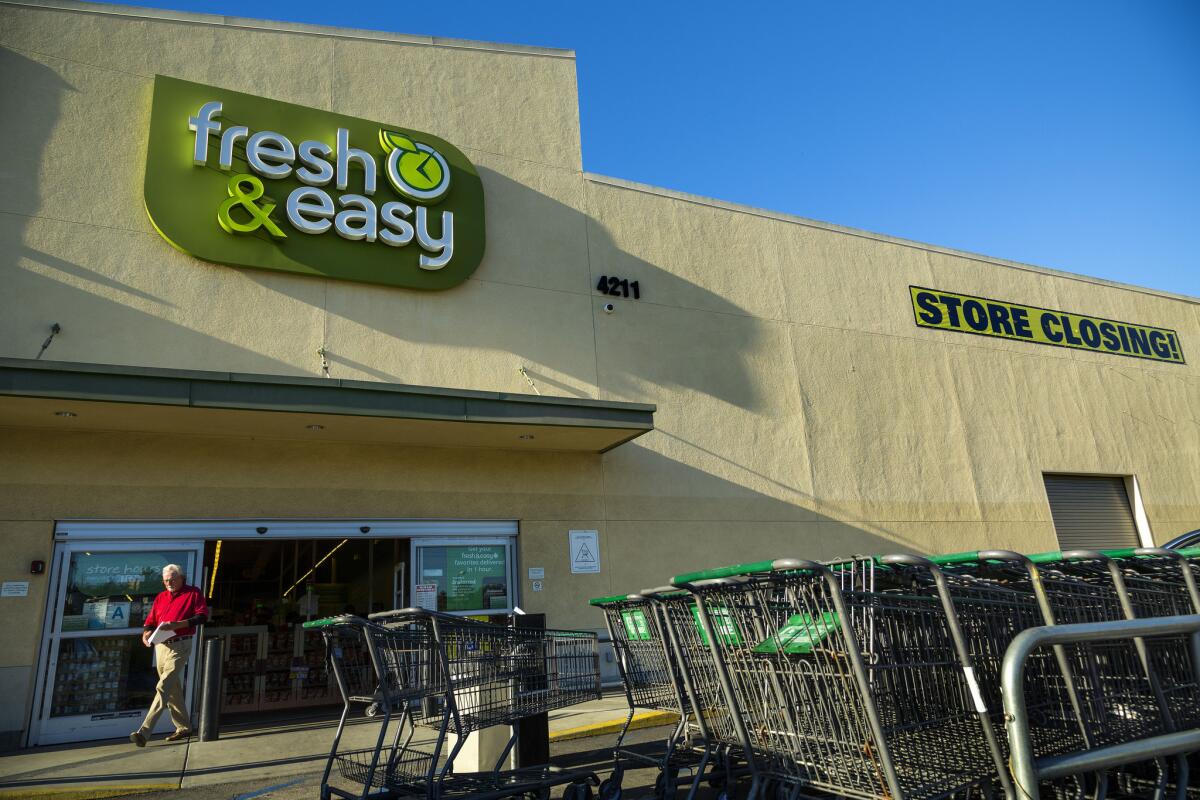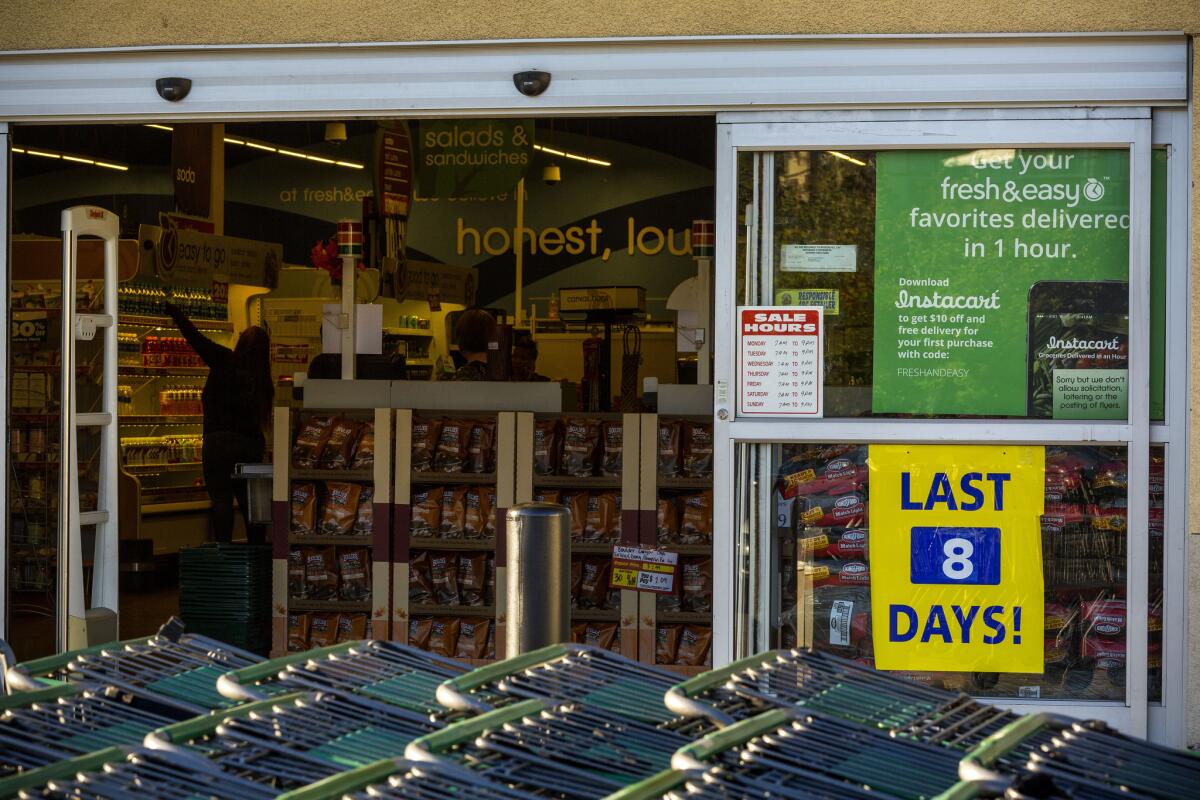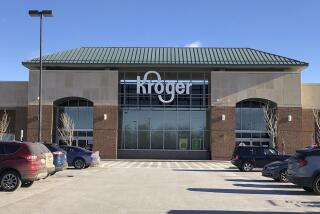Billionaire investor Ron Burkle says bankrupt Fresh & Easy ‘was in a free fall’

Ron Burkle could not save Fresh & Easy, which is closing all of its stores by mid-November.
- Share via
Ronald W. Burkle said his investment firm, Yucaipa Cos., tried its hardest to save Fresh & Easy, the struggling grocery chain that filed for bankruptcy protection last month but ultimately couldn’t overcome bad decisions made by the previous owner.
The billionaire investor, who made his fortune in the supermarket business, gave his take on why Fresh & Easy failed in a statement to The Times.
Last month, the El Segundo company filed for Chapter 11 bankruptcy for the second time in two years. Stores will be closed by mid-November, and about 3,000 people will lose their jobs.
Burkle’s Yucaipa took over more than 150 Fresh & Easy stores following the chain’s 2013 bankruptcy. Yucaipa got a $120-million loan from Tesco, the British supermarket giant that had tried to win over U.S. shoppers, but ended up losing more than $2 billion on the venture.
Analysts said Fresh & Easy was facing increasing competition in the supermarket industry. Local favorites like Trader Joe’s were opening new locations, while big-box retailers like Wal-Mart had beefed up their food offerings. Even online powerhouses Amazon.com and Google were experimenting with grocery delivery.
During the 2013 bankruptcy, Tesco “decided to literally give us and the team half the company to see if we could save the jobs and their investment,” Burkle wrote.
Burkle said he thought “long and hard about investing our time and reputation to turn these stores around.”
“The business was in a free fall,” Burkle wrote. “Turnarounds are tough, and falling knives are tougher yet.”
Fresh & Easy was losing as much as $250 million a year, which was “horrifying,” Burkle said. But Tesco already had invested over $2 billion and provided nearly $200 million in seed money, he said.

A sign indicating the last eight days of the store’s opening is posted on the door of a Fresh & Easy. The chain filed for bankruptcy protection last month and is closing its stores by mid-November.
“The chance would never come again to build something from an infrastructure like they had created,” Burkle wrote. “In many ways, Fresh & Easy was a great opportunity to bring a new format to the market.”
Yucaipa decided to back James Keyes, a former 7-Eleven chief executive who was brought on to turn around Fresh & Easy. His vision, analysts and employees said, was to transform Fresh & Easy into a chain of healthy convenience stores, a sort of organic minimart.
Keyes and his team invested about $1 million into every Las Vegas store to reposition them, and spent an additional $10 million in advertising in that region, Burkle said.
But the experiment didn’t pay off.
“It didn’t move the needle enough to justify further investment,” he wrote. “It was a big disappointment.”
In Arizona, Fresh & Easy tried to rebrand a Scottsdale store under the banner Wild Oats, an organic and natural foods market owned by Burkle. It was a success but was unlikely to thrive in some of places where Tesco had located its stores, Burkle said.
“The problem is that Tesco opened stores in every demographic,” Burkle said. “There weren’t enough Wild Oats store locations to justify a company.”
Some analysts have pointed out that Yucaipa never felt confident enough about the healthy-convenience idea to plunge millions more into the project, which would have required closing stores in undesirable locations and opening new shops in better locales.
“Obviously they didn’t have such great faith in the concept,” said Jim Prevor, food analyst and founder of the Perishable Pundit. “That involved totally rebranding the stores and rebranding the private-label product and doing marketing and advertising to tell consumers.”
Over the past two years, Keyes managed to cut losses to $50 million a year from $250 million, Burkle said. After closing some stores, Fresh & Easy had around 90 stores making about $20 million.
But Burkle said the giant distribution center in Riverside County, which Tesco had built anticipating a rapid expansion before intense competition cut the retailer’s ambitions, “needed many times that many stores to break even.”
“We didn’t make the bad decisions that created the problems,” he said.
Burkle, who is not on the Fresh & Easy board, said he went with Keyes to Tesco to see whether it would be willing to put up more capital to continue trying to save Fresh & Easy.
“I flew to London on my own nickel to support Jim,” Burkle wrote. But the new management at Tesco, he said, didn’t want to be associated with the old team’s Fresh & Easy investment.
“At that point, there were few options,” he said, “none of them good.”
Burkle said that he tells himself that Fresh & Easy workers got two more years of employment and are looking for work in a better economy. He said the company has “guaranteed severance and stay pay.”
“This is really tough on a lot of people,” he wrote. “We all feel badly for the employees, suppliers and customers who are impacted by this.”
Angry employees already have filed suit accusing Fresh & Easy of violating state rules that require at least 60 days’ notice for layoffs. Several workers said that only managers have been told they would get severance and that lower-level workers like cashiers would not.
“We don’t like to lose,” Burkle said, “but as Reverend Jackson says, ‘The only guys with clean uniforms are on the bench.’ ”
Follow Shan Li on Twitter: @ByShanLi
MORE FROM BUSINESS
Strong jobs data set stage for rate hike
Activision Blizzard launches movie and TV studio
Social Security rule changes may affect retirement strategy
More to Read
Inside the business of entertainment
The Wide Shot brings you news, analysis and insights on everything from streaming wars to production — and what it all means for the future.
You may occasionally receive promotional content from the Los Angeles Times.










